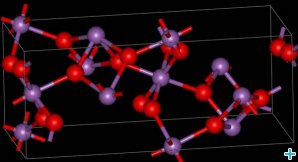Chemistry of the solid state
Chemical Structure, Kinetics and Dynamics
Our informed understanding of the materials world around us is based upon a detailed knowledge of the structure and dynamics of materials on the atomic and molecular level. Molecular and supramolecular structures with sizes from tenths to hundreds of nanometers can be probed by diffraction and dynamic processes can be studied by inelastic and quasi-elastic spectroscopy in the field of chemistry.
Neutron and X-ray scattering are complementary processes: X-rays scatter from the electrons of an atom while the neutrons probe nuclei. This important difference means that neutrons have the ability to accurately locate light elements in the surrounding of heavy atoms.
Scattering from the nucleus in non-magnetic systems avoids any effect due to charge transfer and thus gives valuable information on the chemical bond. Isotopic effects and contrast between neighbouring elements are also an advantage as compared to X-rays. Neutrons scatter relatively weakly, but the cross-section is well understood and the high penetration depth of neutrons allows measurements under extreme conditions of pressure and temperature, or in-beam chemical reaction measurements on large components.
Neutron diffraction gives a unique structural fingerprint of the crystalline state. Light atoms are detected with high precision even in the presence of heavy atoms such as transition metals and actinides. In materials science, archetypal examples include hydrogen storage materials such as metal hydrides, and mixed metals oxides such as high temperature, superconductors, colossal magnetoresistance materials and battery materials .
Since the chemistry of a mixed-metal oxide is determined principally by the location of the light oxygen atoms neutron diffraction is the technique of choice for such measurements.
In organic chemistry, the precise location of hydrogen atoms free from charge transfer effects contributes to our detailed understanding of hydrogen bonding from simple model peptide systems to supramolecular chemistry. The possibility of isotopic replacement, and in particular H/D substitution, can be used to great advantage in elucidating specific structural details.
Neutron scattering methods
Research into chemical structure, kinetics and dynamics requires a broad suite of instruments covering elastic, inelastic and quasi-elastic scattering and reflectometry: high resolution powder diffractometer, high energy chopper, chemical single crystal diffractometer, high resolution Neutron Spin Echo spectometer, cold and thermal choppers, backscattering spectrometers, high intensity reflectometer, high intensity SANS, high Q powder diffractometer, single pulse diffractometer, magnetic powder diffractometer.
For examples of research in this field please visit the ILL chemistry pages.
![Ball-and-stick model of part of the crystal structure of polythiazyl, (SN)x. Picture by By Ben Mills (Own work) [Public domain], via Wikimedia Commons Polythiazyl](../../polythiazyl-neutron-3d-balls-a-rex_img_type=content_half_pop&rex_img_file=polythiazyl-neutron-3d-balls-a.jpg.jpg)

